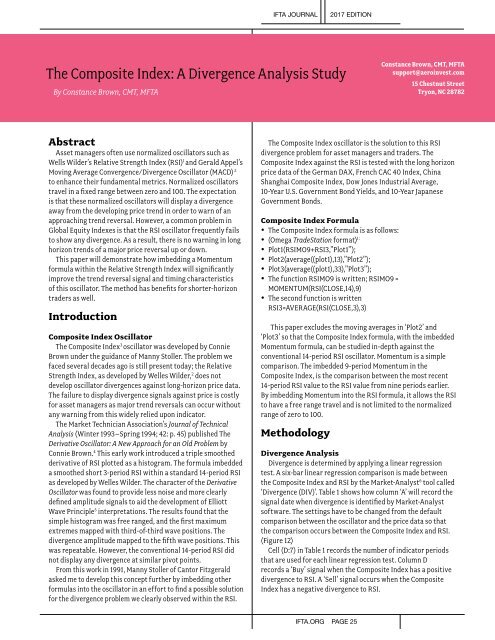Create successful ePaper yourself
Turn your PDF publications into a flip-book with our unique Google optimized e-Paper software.
IFTA JOURNAL<br />
2017 EDITION<br />
The Composite Index: A Divergence Analysis Study<br />
By Constance Brown, CMT, MFTA<br />
Constance Brown, CMT, MFTA<br />
support@aeroinvest.com<br />
15 Chestnut Street<br />
Tryon, NC 28782<br />
Abstract<br />
Asset managers often use normalized oscillators such as<br />
Wells Wilder’s Relative Strength Index (RSI) 1 and Gerald Appel’s<br />
Moving Average Convergence/Divergence Oscillator (MACD) 2<br />
to enhance their fundamental metrics. Normalized oscillators<br />
travel in a fixed range between zero and 100. The expectation<br />
is that these normalized oscillators will display a divergence<br />
away from the developing price trend in order to warn of an<br />
approaching trend reversal. However, a common problem in<br />
Global Equity Indexes is that the RSI oscillator frequently fails<br />
to show any divergence. As a result, there is no warning in long<br />
horizon trends of a major price reversal up or down.<br />
This paper will demonstrate how imbedding a Momentum<br />
formula within the Relative Strength Index will significantly<br />
improve the trend reversal signal and timing characteristics<br />
of this oscillator. The method has benefits for shorter-horizon<br />
traders as well.<br />
Introduction<br />
Composite Index Oscillator<br />
The Composite Index 3 oscillator was developed by Connie<br />
Brown under the guidance of Manny Stoller. The problem we<br />
faced several decades ago is still present today; the Relative<br />
Strength Index, as developed by Welles Wilder, 2 does not<br />
develop oscillator divergences against long-horizon price data.<br />
The failure to display divergence signals against price is costly<br />
for asset managers as major trend reversals can occur without<br />
any warning from this widely relied upon indicator.<br />
The Market Technician Association’s Journal of Technical<br />
Analysis (Winter 1993–Spring 1994; 42: p. 45) published The<br />
Derivative Oscillator: A New Approach for an Old Problem by<br />
Connie Brown. 4 This early work introduced a triple smoothed<br />
derivative of RSI plotted as a histogram. The formula imbedded<br />
a smoothed short 3-period RSI within a standard 14-period RSI<br />
as developed by Welles Wilder. The character of the Derivative<br />
Oscillator was found to provide less noise and more clearly<br />
defined amplitude signals to aid the development of Elliott<br />
Wave Principle 5 interpretations. The results found that the<br />
simple histogram was free ranged, and the first maximum<br />
extremes mapped with third-of-third wave positions. The<br />
divergence amplitude mapped to the fifth wave positions. This<br />
was repeatable. However, the conventional 14-period RSI did<br />
not display any divergence at similar pivot points.<br />
From this work in 1991, Manny Stoller of Cantor Fitzgerald<br />
asked me to develop this concept further by imbedding other<br />
formulas into the oscillator in an effort to find a possible solution<br />
for the divergence problem we clearly observed within the RSI.<br />
The Composite Index oscillator is the solution to this RSI<br />
divergence problem for asset managers and traders. The<br />
Composite Index against the RSI is tested with the long horizon<br />
price data of the German DAX, French CAC 40 Index, China<br />
Shanghai Composite Index, Dow Jones Industrial Average,<br />
10-Year U.S. Government Bond Yields, and 10-Year Japanese<br />
Government Bonds.<br />
Composite Index Formula<br />
• The Composite Index formula is as follows:<br />
• (Omega TradeStation format) 1:<br />
• Plot1(RSIMO9+RSI3,”Plot1”);<br />
• Plot2(average((plot1),13),”Plot2”);<br />
• Plot3(average((plot1),33),”Plot3”);<br />
• The function RSIMO9 is written; RSIMO9 =<br />
MOMENTUM(RSI(CLOSE,14),9)<br />
• The second function is written<br />
RSI3=AVERAGE(RSI(CLOSE,3),3)<br />
This paper excludes the moving averages in ‘Plot2’ and<br />
‘Plot3’ so that the Composite Index formula, with the imbedded<br />
Momentum formula, can be studied in-depth against the<br />
conventional 14-period RSI oscillator. Momentum is a simple<br />
comparison. The imbedded 9-period Momentum in the<br />
Composite Index, is the comparison between the most recent<br />
14-period RSI value to the RSI value from nine periods earlier.<br />
By imbedding Momentum into the RSI formula, it allows the RSI<br />
to have a free range travel and is not limited to the normalized<br />
range of zero to 100.<br />
Methodology<br />
Divergence Analysis<br />
Divergence is determined by applying a linear regression<br />
test. A six-bar linear regression comparison is made between<br />
the Composite Index and RSI by the Market-Analyst 6 tool called<br />
‘Divergence (DIV)’. Table 1 shows how column ‘A’ will record the<br />
signal date when divergence is identified by Market-Analyst<br />
software. The settings have to be changed from the default<br />
comparison between the oscillator and the price data so that<br />
the comparison occurs between the Composite Index and RSI.<br />
(Figure 12)<br />
Cell (D:7) in Table 1 records the number of indicator periods<br />
that are used for each linear regression test. Column D<br />
records a ‘Buy’ signal when the Composite Index has a positive<br />
divergence to RSI. A ‘Sell’ signal occurs when the Composite<br />
Index has a negative divergence to RSI.<br />
IFTA.ORG PAGE 25


